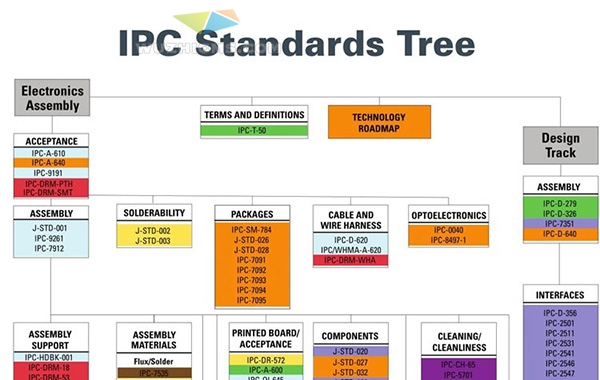Here is IPC standard for flex circuits and rigid-flex circuits.
Flex PCB Standards
Design
|
IPC-FC-2221 |
Generic Standard On Printed Board Design |
|
IPC-FC-2222 |
Sectional Design Standard for Rigid Organic Printed Boards |
|
IPC-FC-2223 |
Sectional Design Standard for Flexible Printed Boards |
Materials
|
IPC-4202 |
Flexible Base Dielectrics for Use in Flexible Printed Circuitry |
|
IPC-4203 |
Adhesive Coated Dielectric Films for Use as Cover Sheets for Flexible Printed Circuitry and Flexible Adhesive Bonding Films |
|
IPC-4204 |
Flexible Metal-Clad Dielectrics |
Performance
|
IPC-6011 |
Generic Performance Specification for Printed Boards |
|
IPC-6012 |
Qualification and Performance Specification for Rigid Printed Boards |
|
IPC-6013 |
Qualification and Performance Specification for Flexible Printed Boards Download PDF |
Quality Guidelines - Circuits & Assembly
|
IPC-A-600 |
Acceptability of Circuit Boards |
|
IPC-A-610 |
Acceptability of Printed Circuit Board Assemblies |
|
IPC/EIA J-STD001 |
Requirements for Soldered Electrical and Electronic Assemblies |
Military
|
MIL-P-50884 |
Military Specification: Printed Wiring Board,Flexible or Rigid-Flex |
|
MIL-PRF-31032 |
Performance Specification:printed Circuit Board/Printed Wiring Board,General Specification |
IPC-6013 Class 3 (C) meets the same performance requirements as MIL-PRF-31032, and is accepted by government agencies as a COTS equivalent of the latter. If your flex circuit must meet performance requirements of MIL-P-50884, MIL-PRF-31032 or IPC6013, follow the IPC-2223 design specification recommendations.

Comparison of the new IPC-6013 to the old MIL-P-5088
(major highlighted differences)
1) Ease of use:
IPC contains an index and paragraphs are easy to follow. Specification tries to promote communication between manufacturer and user.
MIL is not user friendly and requires user to refer to many different paragraphs.
2) How current are specifications:
IPC contains all updated specifications.
MIL needs updating to current specifications.
3) Specification addresses different performance level requirements
IPC contains three performance levels (1, 2, 3).
Class 1- general use; Class 2 - industrial use; Class 3 – high reliability
MIL has one performance level only (basically high reliability). This can result in unnecessary testing and other costs when lower performance requirements may satisfy the application.
4) Rigid/Flex transition zone
IPC allows for visual imperfections in this zone that do not cause any functional degradation.
MIL does not address this area. Defaults to surface and sub-surface imperfections which
do not adequately address anomalies that frequently occur in this zone. This results in unwarranted rejections or indecision.
5) Foreign Material (conductive and non-conductive)
IPC translucent foreign material is acceptable. All other foreign material is acceptable provided it is not closer than the minimum spacing on the drawing.
MIL must not be conductive, not be >.031”, not reduce spacing >25%, and not propagate. This results in rejections that in most cases do not affect performance.
6) Measling and Crazing
IPC did an extensive study and found that these conditions do not cause any degradation in the performance of the printed wiring board and therefore concluded that “measling” and ”crazing” are not rejectable items.
MIL measling and crazing must conform to sub-surface imperfections requirements. This results in unwarranted rejections that were proven not to have any performance degradation.
7) Solder Wicking
IPC specifically limits the amount of solder wicking by class.
MIL does not address this condition, therefore results in indecision.
8) Minimum Annular Ring
IPC depends on Class. Class 3 is .002” external and .001” internal. Other classes are less stringent.
This recognizes designs are becoming smaller and require tighter geometry’s.
MIL .005” min. for external and .002” min. for internal.
9) Solder Coating and Fused Tin-Lead
IPC solder finish must have coverage and be solderable
MIL solder coating must be .0003” min at the crest on the surface, .0001” min. at the crest in the
hole and coverage at the “knee” of the hole. Tin Lead coating must be .0003” min. before fusing. HASL has never met MIL-P-50884, however it is method most widely used for soldering today.
10) Organic Solderability Preservative (OSP) coatings
IPC allows use of this technology. MIL does not address this technology.
11) Copper Thickness after processing
IPC minimum copper foil thickness after processing is clearly defined
MIL not addressed. There is no minimum accepted value for how much copper can be removed during Processing.
12) Qualification
IPC to be agreed upon by user and supplier. Can be pre-production samples, production samples, test specimens (i.e. IPC-A-41, 42 or 43), or based on documentation from testing of specimens furnished on similar product. There is no QPL listing
MIL must submit test specimens using artwork pattern IPC-A-41,42 or 43 and pass a Qualification Certification testing every 3 years. A QPL list is generated.
13) Coupon Design
IPC Coupon design is per IPC-2221. Coupon design tries to represent circuit pattern. MIL Coupon design per MIL-STD-2118. Coupon does not represent the circuit.










 2022-11-10
2022-11-10
 BEST
BEST

.png)
.png)
.png)
.png)

.png)

